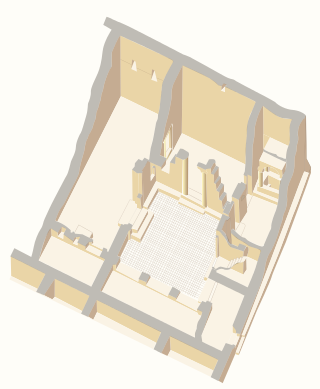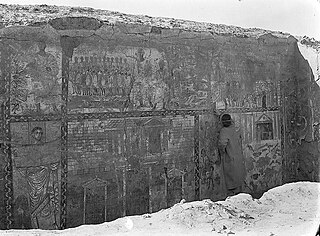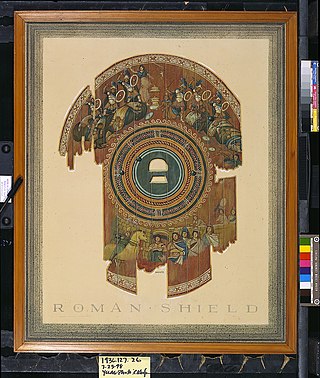
Dura-Europos was a Hellenistic, Parthian, and Roman border city built on an escarpment 90 metres above the southwestern bank of the Euphrates river. It is located near the village of Salhiyé, in present-day Syria. Dura-Europos was founded around 300 BC by Seleucus I Nicator, who founded the Seleucid Empire as one of the Diadochi of Alexander the Great. In 113 BC, Parthians conquered the city, and held it, with one brief Roman intermission, until 165 AD. Under Parthian rule, it became an important provincial administrative centre. The Romans decisively captured Dura-Europos in 165 AD and greatly enlarged it as their easternmost stronghold in Mesopotamia, until it was captured by the Sasanian Empire after a siege in 256–257 AD. Its population was deported, and the abandoned city eventually became covered by sand and mud and disappeared from sight.

The Dura-Europos synagogue was an ancient synagogue uncovered at Dura-Europos, Syria, in 1932. The synagogue contains a forecourt and house of assembly with painted walls depicting people and animals, and a Torah shrine in the western wall facing Jerusalem. It was built backing on to the city wall, which was important in its survival. The last phase of construction was dated by an Aramaic inscription to 244 CE, making it one of the oldest synagogues in the world. It was unique among the many ancient synagogues that have emerged from archaeological excavations as the structure was preserved virtually intact, and it had extensive figurative wall-paintings, which came as a considerable surprise to scholars. These paintings are now displayed in the National Museum of Damascus.

Mikhail Ivanovich Rostovtzeff, or Rostovtsev, was a Russian historian whose career straddled the 19th and 20th centuries and who produced important works on ancient Roman and Greek history. He was a member of the Russian Academy of Science, the American Academy of Arts and Sciences, and the American Philosophical Society.

Alice Schille (1869–1955) was an American watercolorist and painter from Columbus, Ohio. She was renowned for her Impressionist and Post Impressionist paintings, which usually depicted scenes featuring markets, women, children, and landscapes. Her ability to capture the character of her subjects and landscapes often resulted in her winning the top prize in art competitions. She was also known for her versatility in painting styles; her influences included the “Dutch Old Masters, James McNeill Whistler, the Fauves, and Mexican muralists.” Her estate is represented by Keny Galleries in Columbus, OH.

The National Museum of Damascus is a museum in the heart of Damascus, Syria. As the country's national museum as well as its largest, this museum covers the entire range of Syrian history over a span of over 11 millennia. It displays various important artifacts, relics and major finds most notably from Mari, Ebla and Ugarit, three of Syria's most important ancient archaeological sites. Established in 1919, during King Faisal's Arab Kingdom of Syria, the museum is the oldest cultural heritage institution in Syria.

Dura Parchment 24, designated as Uncial 0212, is a Greek uncial manuscript of the New Testament. The manuscript has been assigned to the 3rd century, palaeographically, though an earlier date cannot be excluded. It contains some unusual orthographic features, which have been found nowhere else.

Carl Hermann Kraeling (1897–1966), an American theologian, historian, and archaeologist; born in Brooklyn on March 10, 1897, and died in New Haven on November 14, 1966; he is known for his publications on the synagogue and the Christian chapel of Dura-Europos.

The Dura-Europos church is the earliest identified Christian house church. It was located in Dura-Europos, Syria, and one of the earliest known Christian churches. It is believed to have been an ordinary house that was converted to a place of worship between 233 and 256, and appears to have been built following the Durene tradition, distinguished by the use of mud brick and a layout consisting of rooms encircling a courtyard, which was characteristic of most other homes built in the Dura-Europos region. Prior to the town being abandoned in 256 during the Persian siege, the Romans built a ramp extending from the city wall which buried the church building in a way that allowed for the preservation of its walls, enabling its eventual excavation by archaeologists in 1933. It was less famous, smaller, and more-modestly decorated than the nearby Dura-Europos synagogue, though there are many similarities between them.
Count Robert du Mesnil du Buisson was a French historian, soldier, and archeologist. He was noted for his early use of geophysical survey for archaeology. He was the son of Auguste, comte du Mesnil du Buisson and Berthe Roussel de Courcy, and married Jeanne Leclerc de Pulligny on 26 June 1923. He was the nephew of the geologist Geoffroy d'Ault du Mesnil. He named one of his daughters Ita after the Sphinx found at Ita.

Clark Hopkins was an American archaeologist. During the 1930s he led the joint French-American excavations at Dura Europos. In later years he was professor of art and archeology at the University of Michigan.

Parthian art was Iranian art made during the Parthian Empire from 247 BC to 224 AD, based in the Near East. It has a mixture of Persian and Hellenistic influences. For some time after the period of the Parthian Empire, art in its styles continued for some time. A typical feature of Parthian art is the frontality of the people shown. Even in narrative representations, the actors do not look at the object of their action, but at the viewer. These are features that anticipate the art of medieval Europe and Byzantium.

The Temple of the Gadde is a temple in the modern-day Syrian city of Dura-Europos, located near the agora. It contained reliefs dedicated to the tutelary deities of Dura-Europos and the nearby city of Palmyra, after whom the temple was named by its excavators. The temple was excavated between 1934 and January 1936 by the French/American expedition of Yale University, led by Michael Rostovtzeff.

The Temple of Bel, also known as the Temple of the Palmyrene gods, was located in Dura Europos, an ancient city on the Euphrates, in modern Syria. The temple was established in the first century BC and is celebrated primarily for its wall paintings. Despite the modern names of the structure, it is uncertain which gods were worshipped in the structure. Under Roman rule, the temple was dedicated to the Emperor Alexander Severus. In that period, the temple was located within the military camp of the XXth Palmyrene cohort.

The Temple of Zeus Theos at Dura Europos was built in the second century AD and was among the most important sanctuaries of the city. The structure was located in the centre of the settlement. It had an area of around 37 m2 and took up half an insula. It was excavated by an American-French team between December 1933 and March 1939.

Susan M. Hopkins (1900–1969) was an archaeologist known for her work on the excavations at Dura-Europos.

The scutum from Dura-Europos is the only surviving semi-cylindrical shield (scutum) from Roman times. It is now in the Yale University Art Gallery. The shield was found in the excavation campaign of 1928/37 on Tower 19 of Dura-Europos. The city was besieged by the Sassanids in 256, eventually captured and destroyed. The dry climate enables very good conservation conditions for organic materials such as wood. Since the city housed a Roman garrison and was lost during a siege, a particularly large number of weapons were found during the excavations.

The Mithraeum of Dura Europos was found during excavations in the city in 1934. It is considered to be one of the best-preserved and best-documented cult buildings of Mithraism.

The Temple of Aphlad was an ancient temple located in the southwestern corner of Dura Europos, and dedicated to the god Aphlad. Aphlad was originally a Semitic Mesopotamian god from the city of Anath, and presence of his cult in Dura is revealing of its religious and cultural diversity. The temple itself consists of an open courtyard with multiple scattered rooms and altars, similar to the Temple of Bel, which was located in an analogous position in the northwestern corner of Dura.

The Homeric shield is one of three figural painted shields found together in an embankment within a Roman garrison during the excavations of Dura-Europos. Dura-Europos was a border city of various empires throughout antiquity, and in modern archaeology is noteworthy for its large amount of well-preserved artifacts. Having been virtually untouched for centuries, and with favorable soil, an unusual amount of organic material has been preserved at Dura-Europos. This shield and those found alongside it date from the middle of the 3rd century CE, a period in which a large portion of the city was co-opted as a Roman military base. The shields were deliberately discarded unfinished during the Sassanian siege of Dura Europos. It is widely believed to depict two scenes from the Trojan war: the admission of the Trojan horse into Troy, and the subsequent sack of the city. It is one of few examples of Roman painting on wood, and one of very few Roman painted wooden shields to have survived from antiquity. The shield has now deteriorated beyond most detail being discernible to the naked eye. This is due to the unintended adverse effects of a binding agent applied to the shield in the 1930s in the hopes of preserving the pigmentation.

The building that is referred to as the Priests' House, or House of Priests, at Dura-Europos near the village of Salhiyah in eastern present-day Syria, is one of three buildings that was excavated in block H2. It is hypothesized to be the home of priests from the Temple of Atargatis based on its proximity to the two neighboring temples and graffiti found in the third Excavation season.

















